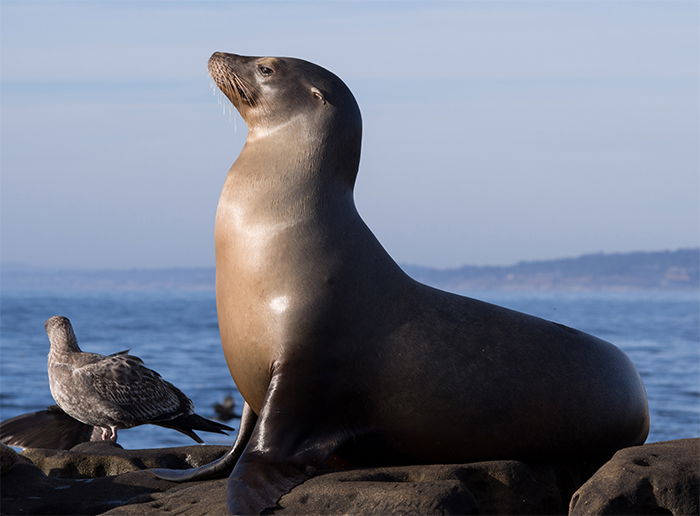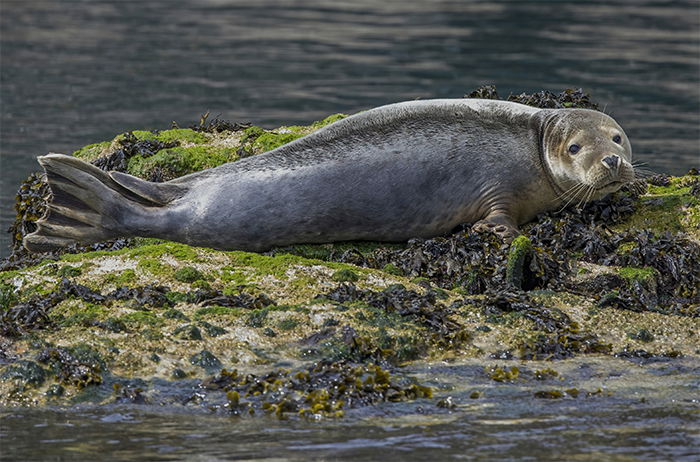Snorkeling with the Garibaldi
(and a Surprise Mammal Showed Up!)
Stan Shebs, CC BY-SA 3.0, via Wikimedia Commons
Hey there, Creation Explorer!
La Jolla (la hoy-ya) Cove is a beautiful stretch of beach in Southern California. It’s part of a 6,000-acre (for reference, one football field is about an acre) ecological reserve which protects that part of the ocean and the creatures that live there. And Trevor and I got the opportunity to snorkel there!

La Jolla Beach, Ameer Basheer via Unsplash
Despite having a reputation for “pleasant swimming temperatures,” the water at La Jolla was very cold (though our guide said that day the water was particularly nice. Maybe it was just us!). But it was beautiful! The water was very clear, letting us see the ocean floor, including sea grasses swaying with the motion of the waves and fish of all sizes darting in and out from among it. The most famous fish in La Jolla are the giant garibaldi which look like aquarium goldfish on steroids.

Garibaldi, Stan Shebs, CC BY-SA 3.0, via Wikimedia Commons
But even more famous than the garibaldi in La Jolla is the California sea lion population that makes its loud and stinky presence known throughout the cove. Now, these sea lions are wild animals, and you should never approach a wild animal—it’s dangerous, and in many cases, illegal (such as with marine mammals, like sea lions). But we actually had a sea lion jump into the water with us and swim under and over us. It was incredible how quickly it moved (they top out at 25 miles per hour!). We could barely catch it on the camera (we have a video from our snorkeling trip for you to enjoy below)!
With strong front and back flippers (the front flippers move them through water, the back ones steer), a streamlined body, and strong muscles, particularly in the shoulders, sea lions have certainly been designed by God for a life among the waves.

Sea Lion, Rhododendrites, CC BY-SA 4.0, via Wikimedia Commons
The Stink Is Real
Now, when it comes to this sea lion population, the stink is real, but the poo responsible for that smell is a good thing. In our fallen world, sea lions eat fish, squid, and octopus (in God’s original creation, they would have been vegetarian, like all other animals). When they poop, the nutrients from this diet of deep ocean creatures becomes available to the plankton, algae, and plants that grow in La Jolla. Those creatures then provide food and protection for many other species.
It’s amazing how God has designed life to be so interconnected. Even in a fallen world, this is a reminder of God’s care for what he has made. He designed nutrients to be recycled and used again so nothing is truly wasted and another generation of creatures can thrive in this world and bring glory to the One who made them.
Seals vs. Sea Lions
Many people confuse seals and sea lions, but they aren’t the same thing! Here’s how you can tell the difference with one glance—sea lions have visible ears, seals don’t. But that’s not the only difference! Sea lions swim with their front flippers, seals use their back ones (that’s why sea lions have big front flippers, but seals have short ones). Sea lions can “walk” on their flippers, but seals flop forward on their bellies. Sea lions are often found in loud groups, but seals are often loners and quite quiet.

Seal, Charles J. Sharp, CC BY-SA 4.0, via Wikimedia Commons
Snorkel with Us in This Fun Video
Enjoy this fun video of the creature friends we met while we were snorkeling.
Well, we’re off on another adventure. Until next time, remember to join with creation in giving glory to the Creator.
“Let the heavens be glad, and let the earth rejoice; let the sea roar, and all that fills it; let the field exult, and everything in it! Then shall all the trees of the forest sing for joy before the Lord” (Psalm 96:11–13a).
P.S. This is the last blog post in our series about our trip last year to San Diego. (You can read about the cacti we encountered in the Anza Borrego Desert and us visiting North America’s rarest pine tree in our other posts).
- © 2024 Answers in Genesis
- Privacy Policy
- Contact
- About
